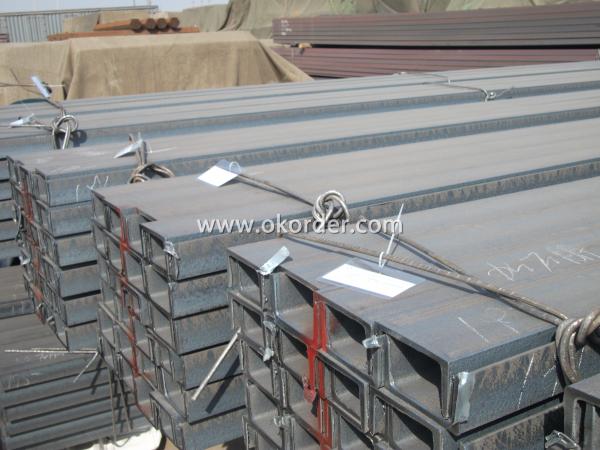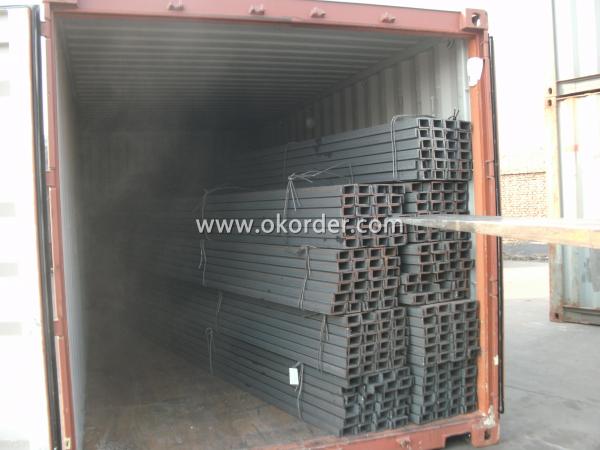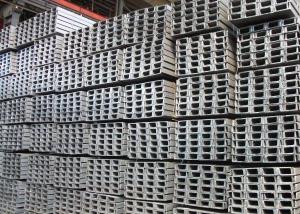Channel Steel
- Loading Port:
- Xingang Port
- Payment Terms:
- TT or LC
- Min Order Qty:
- 25 m.t.
- Supply Capability:
- 80000MTS/YEAR m.t./month
OKorder Service Pledge
OKorder Financial Service
You Might Also Like
Specifications of Channel Steel:
| Original Place | Tangshan, China | Brand Name | Bridge |
| Standard | GB707-88, EN100025, JIS G3192, DIN 1026 | ||
| Sizes | 50mm to 300mm | ||
| Sales Volume/Year | 3000MT | ||
| Main Market | Middle East, Africa, Southeast As | ||
1.We are able to provide channel steel of top quality at attractive price.
2.Our products of channel steel have passed ISO9001:2008 Quality Management System Certification.
3. The section of JIS Standard Channel Steel are as followings in the table.
| JIS U CHANNEL | Standard
h |
Sectional
b |
Dimension
s |
t |
Mass:
Kg/m |
| (mm) | (mm) | (mm) | (mm) | ||
| 50x25 | 50 | 25 | 3.0 | 6.00 | 2.37 |
| 75X40 | 75 | 40 | 3.8 | 7.00 | 5.30 |
| 75X40 | 75 | 40 | 4.0 | 7.00 | 5.60 |
| 75X40 | 75 | 40 | 4.5 | 7.00 | 5.85 |
| 75X40 | 75 | 40 | 5.0 | 7.00 | 6.92 |
| 100X50 | 100 | 50 | 3.8 | 6.00 | 7.30 |
| 100X50 | 100 | 50 | 4.2 | 6.00 | 8.03 |
| 100X50 | 100 | 50 | 4.5 | 7.50 | 8.97 |
| 100X50 | 100 | 50 | 5.0 | 7.50 | 9.36 |
| 125X65 | 125 | 65 | 5.2 | 6.80 | 11.66 |
| 125X65 | 125 | 65 | 5.3 | 6.80 | 12.17 |
| 125X65 | 125 | 65 | 5.5 | 8.00 | 12.91 |
| 125X65 | 125 | 65 | 6.0 | 8.00 | 13.40 |
| 150x75 | 150 | 75 | 5.5 | 7.30 | 14.66 |
| 150x75 | 150 | 75 | 5.7 | 10.00 | 16.71 |
| 150x75 | 150 | 75 | 6.0 | 10.00 | 17.90 |
| 150x75 | 150 | 75 | 6.5 | 10.00 | 18.60 |
4. Chemical Compostion of JIS Standard Channel Steel
| Grade | Element(%) | |||
| C | Mn | P | S | |
| SS330 | -- | -- | ≦0.050 | ≦0.050 |
| SS400 | ||||
| SS490 | ||||
| SS540 | ≦0.30 | ≦1.60 | ≦0.040 | ≦0.040 |
Usage/Applications of Channel Steel:
Channel Steel is usually used for building structure, vehicle manufacturing and other industrial structure and often used with i beam.
In details, the channel steel belongs to carbon structural steel which is applied to in the field of construction and machinery. The channel steel is usually used for arch-itechtural structure, and they could be welded in order to support or hang a vari-ety of facilities. They are also usually used in combination with I beam. Generally,the channel steel must possess perfect welding property, riveting property and mechanical property and so on.
Package & Delivery of Channel Steel:
The steel u channel will be packed in bundle with steel wire at each end of every bundle and color marking in order to help the customer to recognize his goods more easily at sight.
And steel u channel could be loaded into 20ft or 40ft container, or by bulk cargo. If the weight of each bundle reaches less than 3.5 mt, the loading by break bulk cargo should be choosed. When the weight of each bundle reaches less than 3mt, the loading by container should be choosed.
As for the transportaion from mill to loading port, the truck will be usually used. And the maximum quantity for each truck is 40mt.
All in all, we could do in accordance with customer's request.


Production Flow of Channel Steel:
1.The steel billet shall be heated in the high temperature furnace.
2. The heated steel billet shall be rolled five to nine times with the aim of shaping the general figure of steel u channel.
3. The rolled steel u channel should be put onto the cooling bed to make the temperature low.
4. The steel u channel should be straighted on the straightener.
5. The straighted steel u channel will be cut into meters by saw, as per customer's requirements.
- Q:Are steel channels suitable for railway infrastructure projects?
- Yes, steel channels are indeed suitable for railway infrastructure projects. Steel channels are commonly used in railway infrastructure projects due to their high strength and durability. They can support heavy loads and provide stability to the railway structure. Steel channels also have excellent resistance to corrosion and can withstand harsh weather conditions, making them ideal for outdoor applications. Additionally, steel channels can be easily fabricated and installed, which helps to expedite the construction process. Overall, the use of steel channels in railway infrastructure projects ensures the safety and longevity of the railway system.
- Q:Can steel channels be used in the construction of soundproof walls?
- Soundproof walls can be constructed using steel channels. Steel channels, also known as steel studs or metal studs, are widely used in the construction industry due to their strength, durability, and versatility. When building soundproof walls, it is crucial to minimize any gaps or weak spots that could allow sound to pass through. By using steel channels, a solid framework can be created for the wall, ensuring a tight and secure structure that effectively blocks sound transmission. In the construction of soundproof walls, steel channels are typically employed as the framing material. They are installed vertically from floor to ceiling and horizontally between the top and bottom plates to establish a robust framework. This framework is then filled with soundproofing materials like insulation, mass-loaded vinyl, or acoustic panels to enhance the wall's soundproofing capabilities. The rigidity and strength of steel channels make them suitable for supporting heavy soundproofing materials, ensuring the wall remains intact even under significant sound pressure. Furthermore, steel channels are resistant to warping, rotting, and termite infestations, making them a durable option for long-lasting soundproof walls. However, it is important to acknowledge that the overall effectiveness of a soundproof wall depends on various factors, such as the selection of soundproofing materials, construction techniques, and proper installation. Steel channels alone may not provide complete soundproofing, as sound can still travel through other elements like doors, windows, or the ceiling. Therefore, it is essential to adopt a comprehensive approach to soundproofing, addressing all potential weak points in the construction process to achieve optimal results.
- Q:How do steel channels perform under static loads?
- Steel channels, commonly utilized in construction and engineering applications, serve as structural components. Their performance proves outstanding when subjected to static loads, such as the weight of structures or equipment resting upon them. One notable advantage of steel channels lies in their impressive strength-to-weight ratio. Despite being relatively lightweight, they possess the ability to support heavy loads. Steel, renowned for its exceptional strength and durability, showcases these qualities in the performance of steel channels under static loads. Moreover, steel channels exhibit good resistance against deformation and deflection. When a static load is applied, these channels evenly distribute the load and resist bending or sagging. As a result, the stability and integrity of the supported structure or equipment remain intact. Additionally, steel channels boast high resistance to corrosion and environmental factors. This renders them suitable for various conditions, including outdoor and industrial environments. Furthermore, their corrosion resistance contributes to their longevity and low maintenance requirements. Aside from their mechanical properties, steel channels can be effortlessly fabricated and installed. They are available in a wide array of sizes and dimensions, allowing for flexibility in design and construction. Steel channels can be connected securely and reliably through welding or bolting. In summary, steel channels deliver exceptional performance under static loads. Their high strength, resistance to deformation, and durability establish them as a dependable choice for supporting structures and equipment.
- Q:What are steel channels?
- Steel channels, which are shaped like a "C" or a "U," serve as structural components in construction and engineering projects, providing vital support and stability. Frequently employed as beams or columns, they effectively bear heavy loads and evenly distribute weight. Additionally, they find utility as brackets or supports in diverse applications. Renowned for their durability, strength, and resistance to deformation, steel channels have become highly favored in the construction industry. Their availability in a range of sizes and thicknesses ensures suitability for various project needs.
- Q:Can steel channels be used for creating support structures for telecommunications systems?
- Certainly, support structures for telecommunications systems can be created using steel channels. The strength and durability of steel channels make them extensively utilized in construction and engineering. They offer exceptional support for hefty loads and can endure diverse weather conditions, rendering them ideal for outdoor installations of telecommunications. Furthermore, steel channels can be effortlessly fabricated and tailored to fulfill specific design prerequisites, enabling flexibility in the creation of support structures for telecommunications equipment like antennas, cables, and other devices.
- Q:Can steel channels be used in outdoor applications?
- Yes, steel channels can be used in outdoor applications. Steel channels are known for their strength, durability, and resistance to corrosion, making them highly suitable for outdoor use. They are commonly used in construction, infrastructure projects, and outdoor structures where strength and weather resistance are essential.
- Q:Can steel channels be used for platform structures?
- Yes, steel channels can be used for platform structures. Steel channels provide excellent structural support, durability, and load-bearing capacity, making them suitable for constructing stable and reliable platforms.
- Q:How do steel channels compare to I-beams?
- Steel channels and I-beams are both structural components commonly used in construction and engineering projects. However, they differ in their shapes and load-bearing capacities. Steel channels have a U-shaped cross-section, while I-beams have an I-shaped cross-section. I-beams are generally stronger and more rigid than steel channels, making them suitable for supporting heavy loads over long spans. On the other hand, steel channels are often used for lighter applications, such as framing, bracing, and support in smaller structures. Ultimately, the choice between steel channels and I-beams depends on the specific requirements and load-bearing needs of the project.
- Q:What are the different methods of installation for steel channels?
- There are several methods of installation for steel channels, including welding, bolting, and adhesive bonding. Welding involves joining the channels using a high-temperature process that creates a strong and permanent connection. Bolting involves using bolts and nuts to secure the channels together, allowing for easier disassembly if needed. Adhesive bonding utilizes strong adhesives to bond the channels, providing a reliable and versatile installation method. The choice of installation method depends on factors such as the application, load requirements, and ease of installation.
- Q:Are steel channels cost-effective?
- Yes, steel channels are generally considered cost-effective. Steel is known for its durability, strength, and longevity, which makes it a reliable material for various construction and industrial applications. Steel channels are designed to provide structural support, distribute loads, and enhance stability in buildings and infrastructure projects. Additionally, steel channels are readily available and can be easily fabricated to meet specific project requirements. While the initial cost of steel may be higher than other materials, its long-term benefits, such as low maintenance and resistance to corrosion, make it a cost-effective choice in the long run.
1. Manufacturer Overview |
|
|---|---|
| Location | Hebei, China |
| Year Established | 1993 |
| Annual Output Value | Above US$100 Million |
| Main Markets | South Asia Middle East; Southeast Aisa; south Korea |
| Company Certifications | ISO 9001:2000 |
2. Manufacturer Certificates |
|
|---|---|
| a) Certification Name | |
| Range | |
| Reference | |
| Validity Period | |
3. Manufacturer Capability |
|
|---|---|
| a)Trade Capacity | |
| Nearest Port | Tianjin; |
| Export Percentage | 1% - 10% |
| No.of Employees in Trade Department | 11-20 People |
| Language Spoken: | English; Chinese |
| b)Factory Information | |
| Factory Size: | Above 20,000 square meters |
| No. of Production Lines | 1 |
| Contract Manufacturing | OEM service offered |
| Product Price Range | average |
Send your message to us
Channel Steel
- Loading Port:
- Xingang Port
- Payment Terms:
- TT or LC
- Min Order Qty:
- 25 m.t.
- Supply Capability:
- 80000MTS/YEAR m.t./month
OKorder Service Pledge
OKorder Financial Service
Similar products
New products
Hot products
Related keywords





























